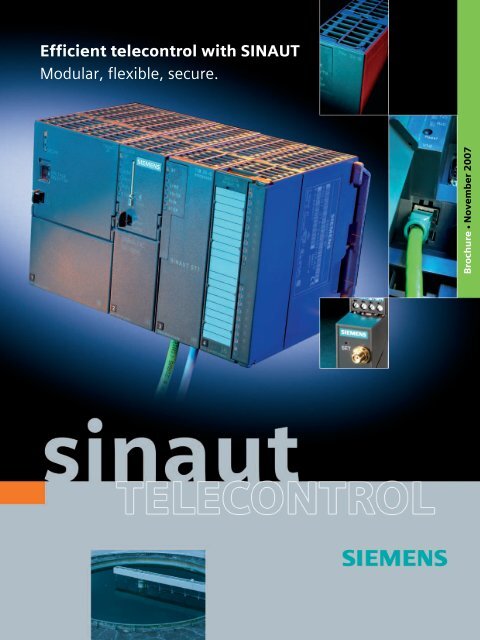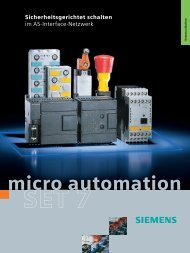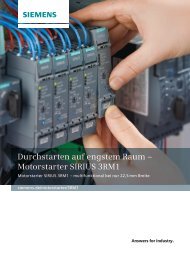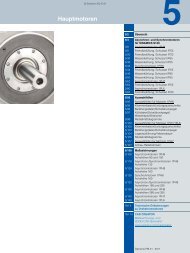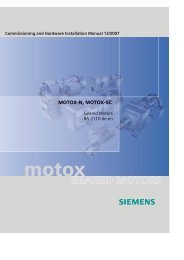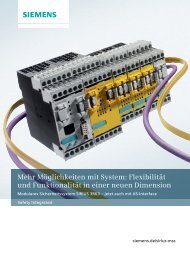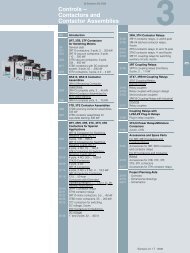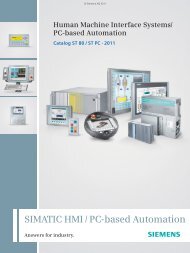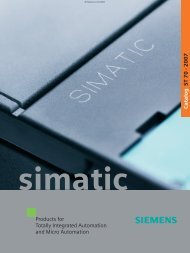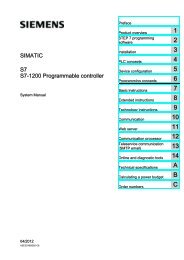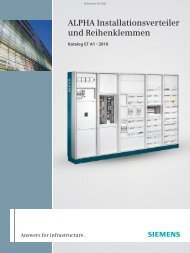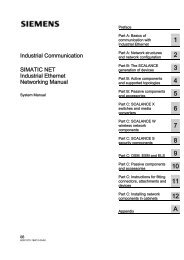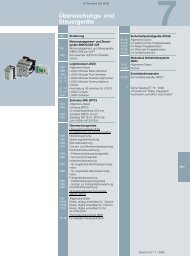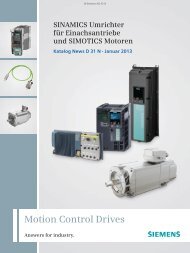Efficient telecontrol with SINAUT Modular, flexible, secure.
Efficient telecontrol with SINAUT Modular, flexible, secure.
Efficient telecontrol with SINAUT Modular, flexible, secure.
You also want an ePaper? Increase the reach of your titles
YUMPU automatically turns print PDFs into web optimized ePapers that Google loves.
<strong>Efficient</strong> <strong>telecontrol</strong> <strong>with</strong> <strong>SINAUT</strong><br />
<strong>Modular</strong>, <strong>flexible</strong>, <strong>secure</strong>.<br />
Brochure • November 2007
Contents Introduction<br />
Introduction<br />
2<br />
<strong>SINAUT</strong> MICRO 4<br />
<strong>SINAUT</strong> ST7 6<br />
Network solutions 8<br />
The control center<br />
Solution examples<br />
11<br />
Water/wastewater 12<br />
Oil production 13<br />
Gas distribution<br />
Migration –<br />
14<br />
an investment for the future<br />
Industry-compatible products for<br />
<strong>telecontrol</strong><br />
15<br />
TIM communications modules 16<br />
Modems and mobile radio components 17<br />
Software 18<br />
Accessories 19<br />
2 <strong>SINAUT</strong> Telecontrol<br />
<strong>SINAUT</strong> Telecontrol<br />
<strong>SINAUT</strong> Telecontrol (Siemens Network Automation) is based<br />
on SIMATIC. It supplements the SIMATIC system <strong>with</strong> corresponding<br />
hardware and software, and permits networking of<br />
individual components over a WAN (Wide Area Network).<br />
Under the generic term WAN, the <strong>SINAUT</strong> system offers solutions<br />
for data transmission over classical WAN, such as copper<br />
dedicated line, telephone network, radio etc., but also over<br />
modern, IP-based WAN, such as broadband systems or the<br />
Internet.<br />
To cover the different requirements, <strong>SINAUT</strong> Telecontrol has<br />
two independent systems:<br />
■ <strong>SINAUT</strong> MICRO<br />
Simple <strong>telecontrol</strong> system for monitoring and control of distributed<br />
plants using mobile radio communication (GPRS)<br />
on the basis of SIMATIC S7-200 and WinCC <strong>flexible</strong> or<br />
WinCC.<br />
■ <strong>SINAUT</strong> ST7<br />
Versatile <strong>telecontrol</strong> system on the basis of SIMATIC S7-300,<br />
S7-400 and WinCC/PCS 7 for fully-automatic monitoring<br />
and control of distributed process stations which exchange<br />
data between each other and one or more control centers<br />
using many different WAN media.<br />
Although <strong>SINAUT</strong> ST7 and <strong>SINAUT</strong> MICRO are independent<br />
systems, they can be combined together in one plant. The<br />
combination is implemented in the control center's PC.
Applications<br />
<strong>SINAUT</strong> has proven itself in small plants <strong>with</strong> only a few<br />
stations but also in complex networks <strong>with</strong> many hundred<br />
stations.<br />
■ Safe supply of private and industrial consumers <strong>with</strong> drinking<br />
water, gas or district heating over branched networks<br />
■ Economical transportation of gas, oil or oil products<br />
through pipelines<br />
■ Reliable recording and transmission of process data from<br />
environmental monitoring systems<br />
■ Remote monitoring of wastewater systems<br />
■ Control and monitoring of beacons, unit-type district<br />
heating power stations, conveyor systems or traffic systems<br />
■ Networking of mobile stations such as track vehicles, public<br />
transport or ships if central monitoring and/or control is<br />
required for them.<br />
<strong>SINAUT</strong> Telecontrol 3
<strong>SINAUT</strong> MICRO<br />
<strong>SINAUT</strong> MICRO is appropriate where smaller amounts of data<br />
have to be transmitted to permit monitoring and control of<br />
remote stations using wireless techniques <strong>with</strong> the GPRS service<br />
of the GSM mobile radio network. Both stationary and<br />
mobile stations are easy to link to a master control center<br />
<strong>with</strong>out radio know-how. The GPRS connection is permanently<br />
online, and reacts like a dedicated line. Data can be<br />
transmitted immediately, and the failure of a station is also<br />
recognized immediately. Although permanently connected,<br />
the online time is nowadays hardly of any importance for the<br />
calculation of charges. Tariffs based on data volume – which<br />
are becoming increasingly common <strong>with</strong> GPRS – limit the<br />
costs to the actually transmitted volume of information.<br />
The <strong>SINAUT</strong> MICRO based on SIMATIC S7-200 offers the<br />
MD720-3 GSM/GPRS modem and the <strong>SINAUT</strong> MICRO SC software<br />
package. The software contains blocks for the S7-200<br />
PLC <strong>with</strong> which data transmission and reception are easy to<br />
configure. The package for the control center PC contains a<br />
connection manager responsible for the connection between<br />
the control center and up to 256 S7-200 stations, and also an<br />
OPC server. The latter permits data exchange <strong>with</strong> an OPC<br />
client, e.g. WinCC or WinCC <strong>flexible</strong>, or <strong>with</strong> any other modern<br />
control center software which supports the internationally<br />
recognized OPC standard. If more than 256 stations are<br />
present, several OPC servers can be combined under one OPC<br />
client.<br />
Convenient and reliable generation of alarms<br />
For alarming the on-call service personnel, the additional<br />
package "Alarm Control Center Micro Edition" is recommended.<br />
Alarms that are received from the OPC server of the<br />
<strong>SINAUT</strong> MICRO SC can be transferred to up to four recipients<br />
(mobile phone, fax or printer).<br />
The person responsible in accordance <strong>with</strong> the shift plan is<br />
always directly informed. If this person does not acknowledge<br />
the alarm in time, multi-level escalation management ensures<br />
that an alternative recipient can always be informed.<br />
4 <strong>SINAUT</strong> Telecontrol<br />
Securely over the Internet <strong>with</strong> integral VPN<br />
The control center PC must be permanently accessible from<br />
the GPRS network. It is therefore directly connected to the<br />
GPRS provider over a dedicated line or, as a cheaper solution,<br />
permanently to the Internet, e.g. using DSL. In order to guarantee<br />
the required security <strong>with</strong> data transmission over the<br />
Internet, <strong>SINAUT</strong> MICRO provides its own VPN (Virtual Private<br />
Network). The GSM/GPRS modem then connects to the connection<br />
manager in the control center PC through a VPN tunnel.<br />
Both partners can exchange their data <strong>secure</strong>ly in both<br />
directions through this tunnel. This also allows cross connections<br />
between the stations, which is not possible directly <strong>with</strong><br />
GPRS. The connection manager is assigned a routing function<br />
for this purpose, i.e. it switches the data traffic between the<br />
stations through its own VPN.<br />
Fax<br />
Printer<br />
Cell phone<br />
S7-200 station<br />
<strong>with</strong> modem<br />
<strong>SINAUT</strong> MD720-3<br />
S7-200 station<br />
<strong>with</strong> modem<br />
<strong>SINAUT</strong> MD720-3<br />
Central control center<br />
Alarm Control<br />
Center<br />
Micro Edition<br />
option for<br />
Alarm<br />
Internet<br />
GSM/GPRSprovider<br />
OPC Client<br />
e.g. WinCC<br />
<strong>flexible</strong>,<br />
WinCC<br />
<strong>SINAUT</strong> MICRO SC<br />
OPC server and connection<br />
manager<br />
S7-200 station<br />
<strong>with</strong> modem<br />
<strong>SINAUT</strong> MD720-3<br />
G_IK10_XX_30159
Data communication<br />
The <strong>SINAUT</strong> MICRO SC software package includes a block library<br />
for the SIMATIC S7-200 PLC. Using these blocks and the<br />
MICRO SC software for the PC control center, users can implement<br />
the following types of data exchange:<br />
Station 1<br />
Station 1 sends data to control center<br />
Station 1<br />
data<br />
Control center sends data to station 1<br />
Station 1<br />
data<br />
data<br />
Control center scans data at station 1<br />
Control center<br />
simatic hmi<br />
Control center<br />
simatic hmi<br />
Control center<br />
simatic hmi<br />
Data exchange between <strong>telecontrol</strong> station and control center<br />
G_IK10_XX_30045<br />
Station 1<br />
Station 2<br />
Station 1 sends data to station 2<br />
Station 1<br />
Station 2<br />
data<br />
data<br />
data<br />
Station 1 scans data at station 2<br />
Control center<br />
data<br />
simatic hmi<br />
Control center<br />
simatic hmi<br />
Data exchange between two <strong>telecontrol</strong> stations via the control center<br />
Access to the S7-200 PLC per Teleservice<br />
Up to three telephone numbers can be saved on the <strong>SINAUT</strong><br />
MD720-3 modem, from which a teleservice connection is permissible.<br />
If a call is made from one of the approved numbers,<br />
the MD720-3 interrupts the GPRS connection and provides the<br />
Teleservice connection to the PLC. The GPRS connection is reestablished<br />
at the end of the Teleservice session.<br />
G_IK10_XX_30046<br />
<strong>SINAUT</strong> Telecontrol 5
<strong>SINAUT</strong> ST7<br />
The <strong>SINAUT</strong> ST7 <strong>telecontrol</strong> system is recommended for all applications<br />
where remote process stations are used connected<br />
to one or more control centers. <strong>SINAUT</strong> ST7 is based on the<br />
SIMATIC S7-300 and S7-400 systems as well as on WinCC/<br />
PCS 7. For communication over WAN, it supports these systems<br />
<strong>with</strong> the required hardware and software components.<br />
Versatility and modularity – both in the design of the process<br />
stations and in the selection and combination of the available<br />
networks and transmission paths – are two of the decisive advantages<br />
of this <strong>telecontrol</strong> system.<br />
Data communication<br />
Communication <strong>with</strong> <strong>SINAUT</strong> is event-controlled. Operators<br />
are therefore quickly provided <strong>with</strong> alarms, stati and values<br />
from the process even <strong>with</strong> narrowband networks or a large<br />
number of connected stations, and can influence the process<br />
control by entering commands or setpoints at any time.<br />
Parallel to this, important events can be sent to a mobile<br />
phone by SMS – if required also <strong>with</strong> an acknowledgment to<br />
the sending station. Direct data exchange between the process<br />
stations is also possible.<br />
6 <strong>SINAUT</strong> Telecontrol<br />
Transmission networks<br />
<strong>SINAUT</strong> ST7 demonstrates its enormous versatility in the<br />
selection of the transmission network. In the classical WAN<br />
sector, these are:<br />
■ Dedicated lines (private or leased)<br />
■ Private radio networks (optionally <strong>with</strong> time slot procedure)<br />
■ Analog telephone network<br />
■ Digital ISDN network<br />
■ Mobile radio network (GSM)<br />
With the exception of the private radio networks, <strong>SINAUT</strong> ST7<br />
offers suitable modems for all classical WANs.<br />
In addition to the use of these classical networks, <strong>SINAUT</strong><br />
communication is also possible over IP-based WANs, namely:<br />
■ Via radio, by using special radio systems optimized for Ethernet,<br />
e.g. the network components of the IWLAN system<br />
SCALANCE W<br />
■ Via fiber-optic cables, e.g. by using the SCALANCE X<br />
switches <strong>with</strong> optical ports. Distances of up to 70 km can<br />
then be covered, or also in association <strong>with</strong> transmission<br />
systems such as PCM30 or OTN<br />
■ Via public networks and Internet using DSL and/or GPRS<br />
All networks can be mixed in any manner in a <strong>SINAUT</strong> project.<br />
Star, line and node topologies can be designed, and also<br />
mixed configurations of these. A station can be linked to two<br />
transmission paths for redundant data transmission. The two<br />
paths can be of the same type or also different, e.g. dedicated<br />
line combined <strong>with</strong> telephone network or ISDN <strong>with</strong> DSL.<br />
Data security<br />
Comprehensive measures to prevent data falsification and<br />
loss are important components of the <strong>SINAUT</strong> ST7 system.<br />
The <strong>SINAUT</strong> ST7 <strong>telecontrol</strong> protocol guarantees that data<br />
reach the partner uncorrupted. To avoid data losses, each<br />
<strong>SINAUT</strong> ST7 TIM communications module has a large memory<br />
for several thousand data messages. Failure times in the transmission<br />
link or communication partner can then be covered.<br />
This memory is also an advantage for dial-up networks: The<br />
data connections which are otherwise required are reduced to<br />
a minimum.
Time synchronization<br />
To enable subsequent and correct archiving of process data in<br />
the control center system, all data messages are already<br />
assigned a time tag at their place of origin. The complete network<br />
is automatically synchronized (controlled by DCF77 or<br />
GPS), including summer/winter time switchover.<br />
<strong>SINAUT</strong> ST7cc control center system<br />
The standard <strong>SINAUT</strong> control center is based on WinCC/PCS 7<br />
which is expanded <strong>with</strong> the software <strong>SINAUT</strong> ST7cc. This processes<br />
the communication <strong>with</strong> the <strong>SINAUT</strong> stations. It supplies<br />
the archives <strong>with</strong> process data in line <strong>with</strong> the provided<br />
time stamp, and is also able to link sector-typical logging<br />
systems such as ACRON. The additional package "Alarm Control<br />
Center" is recommended for alarming the on-call service<br />
personnel over SMS, fax or e-mail. In order to increase the<br />
availability, the control center can also be designed as a redundant<br />
system in conjunction <strong>with</strong> the WinCC/PCS 7 redundancy<br />
package.<br />
Linking of third-party control systems<br />
Using the <strong>SINAUT</strong> ST7sc program package <strong>with</strong> the Data Access<br />
OPC interface, the <strong>SINAUT</strong> ST7 stations can also be linked<br />
to control systems from other vendors. ST7sc possesses complex<br />
buffer mechanisms which prevent a data loss even upon<br />
failure of the OPC client. All process data are delivered <strong>with</strong> a<br />
time stamp, and the configuring of the OPC interface is also<br />
simple and user-friendly. Depending on the required availability,<br />
<strong>SINAUT</strong> ST7sc can be linked to redundant or non-redundant<br />
clients.<br />
Engineering<br />
The engineering system based on SIMATIC tools permits<br />
graphic configuration of complete communications networks.<br />
The system automatically provides the configuration engineer<br />
<strong>with</strong> all possibilities of linking the individual PLCs. Also possible:<br />
multiple addressing of process data, for example to several<br />
control centers or stations. Plausibility checks and address<br />
comparisons help when configuring complex networks.<br />
Remote programming and diagnostics<br />
Program modifications or remote diagnostics are easy to carry<br />
out in the <strong>SINAUT</strong> remote stations both in the commissioning<br />
phase and during operation, even <strong>with</strong>out interrupting the<br />
current process data communication. This saves traveling<br />
times and maintenance visits.<br />
Future-oriented and economical<br />
<strong>SINAUT</strong> ST7 is a <strong>telecontrol</strong> system produced on the basis of<br />
the SIMATIC S7 automation system, which resumes the successful<br />
properties of the previous <strong>SINAUT</strong> ST1 system based<br />
on SIMATIC S5, while continuing to evolve. The consistent use<br />
of the SIMATIC platform guarantees the long service life and<br />
economy of plant investments, and guarantees compatibility<br />
<strong>with</strong> previous and future systems.<br />
<strong>SINAUT</strong> Telecontrol 7
Network solutions<br />
Control center<br />
MPI<br />
stations<br />
<strong>SINAUT</strong> ST7cc<br />
WinCC<br />
PCS 7<br />
S7-300 / C7<br />
TIM 3V-IE<br />
<strong>SINAUT</strong> ST7sc<br />
OPC-<br />
Client<br />
TIM<br />
4R/4RD<br />
Optional local extension on all levels<br />
<strong>with</strong> additional SIMATIC<br />
components, e.g.:<br />
Network solutions <strong>with</strong> <strong>SINAUT</strong> ST7<br />
8 <strong>SINAUT</strong> Telecontrol<br />
S7-300 / C7<br />
TIM<br />
4R-IE<br />
TIM<br />
3V-IE<br />
Adv.<br />
S7-400<br />
S7-300 / C7<br />
S7-300 / C7<br />
TIM<br />
3V-IE<br />
Adv.<br />
S7-400<br />
Industrial Ethernet<br />
TIM<br />
4R-IE<br />
S7-400 S7-400 S7-400<br />
S7-400<br />
TIM 4R TIM 4R-IE TIM 3V-IE<br />
TIM 4R TIM 4R-IE<br />
Field devices<br />
(e.g. ET 200S, ET 200pro)<br />
Node<br />
station<br />
Operator control & process<br />
monitoring systems<br />
(e.g. SIMATIC HMI)<br />
Industrial Ethernet (LAN, e.g. FO) and IP-based networks<br />
(WAN, e.g. DSL, GPRS, Internet)<br />
Classical WAN (dedicated line, dial-up network ,radio network )<br />
Optional connection to Industrial Ethernet and IP-based networks<br />
Optional connection to classical WAN<br />
MPI-Bus<br />
Drives<br />
(e.g. SINAMICS)<br />
<strong>SINAUT</strong><br />
ST7cc/<br />
ST7sc<br />
Measuring technology<br />
(e.g. SITRANS)<br />
TIM<br />
4R-IE<br />
G_IK10_XX_30206
Telecontrol networks<br />
Telecontrol networks are usually inhomogeneous networks.<br />
Interfacing of the process stations to a <strong>telecontrol</strong> master station<br />
or to a control center system is usually over different<br />
types of network and not over a uniform communications medium.<br />
The <strong>SINAUT</strong> system is configured to combine many different<br />
transmission networks in a project, and to permit communication<br />
<strong>with</strong>in the complete system independent of<br />
interfacing modes and gateways.<br />
Dedicated lines<br />
The classic copper dedicated line (communications cable <strong>with</strong><br />
copper cores twisted in pairs) is still one of the most frequently<br />
encountered types of private dedicated lines.<br />
Using the <strong>SINAUT</strong> dedicated line modem, point-to-point connections<br />
as well as line and star network topologies can be<br />
implemented <strong>with</strong>out problems. A distance of up to 34 km<br />
can be covered <strong>with</strong>out amplification. Larger distances can be<br />
achieved using the modem as a repeater.<br />
If a fiber-optic cable is present instead of a copper dedicated<br />
line, Industrial Ethernet technology is appropriate as the communications<br />
medium, for example the SCALANCE X switches<br />
for FOC. Distances of up to 70 km can be covered, and the<br />
same network topologies can be implemented as <strong>with</strong> copper<br />
dedicated lines. In addition, ring topologies are possible <strong>with</strong><br />
a correspondingly higher security against cable interruptions.<br />
Station<br />
TIM 3V-IE<br />
Radio network<br />
telephone network<br />
MD3<br />
Fiber<br />
Optic<br />
DCF77 / GPS<br />
time signal<br />
TIM<br />
4RD<br />
Switch<br />
SCALANCE X<br />
Station<br />
SCALANCE<br />
X-100<br />
media<br />
converter<br />
<strong>SINAUT</strong> ST7 - communication over different transmission networks<br />
<strong>SINAUT</strong><br />
ST7cc/sc<br />
The advantage of dedicated lines is the permanent accessibility<br />
of the process stations connected. Any data, events or<br />
alarms are transmitted immediately, and failures of stations or<br />
connections are rapidly detected and indicated to the operators.<br />
Furthermore, private dedicated lines offer a maximum<br />
degree of security since they are not publicly accessible.<br />
Dial-up networks<br />
If dedicated lines are not available, one can consider the use<br />
of a dial-up network. This is usually an analog or ISDN telephone<br />
connection, but GSM mobile radio networks can also<br />
be used for data transmission <strong>with</strong> a dial-up connection.<br />
However, since these are charged connections, data transmission<br />
must be optimized <strong>with</strong> regard to connection frequency<br />
and duration. Important information such as alarms requires<br />
immediate transfer, other information should be collected and<br />
transferred bundled once or several times a day. Of decisive<br />
importance is the addition of a time tag in the process station<br />
to ensure that the data can be saved correctly in the control<br />
center's archive.<br />
<strong>SINAUT</strong> ST7 offers corresponding modems for all dial-up networks.<br />
The TIM communications modules enable the buffering<br />
and cost-optimized transmission of data.<br />
MPI Industrial<br />
Ethernet<br />
TIM 3V-IE<br />
MD720-3<br />
Control center<br />
Switch<br />
SCALANCE X<br />
MD720-3<br />
GSM network<br />
TIM 3V-IE MD3<br />
TIM<br />
TIM<br />
TIM MD2<br />
Station Adv. Station 4R-IE Station 3V-IE Station 3V-IE<br />
Station<br />
TIM<br />
4R-IE<br />
RS485<br />
MD2 MD2 MD2<br />
. . .<br />
star-shaped<br />
dedicated line network<br />
. . .<br />
MD2<br />
TIM 4R<br />
<strong>SINAUT</strong> Telecontrol 9<br />
G_IK10_XX_30207
Network solutions<br />
DSL and GPRS<br />
A dial-up connection can, of course, only be used if the process<br />
permits a discontinuous connection. If a dial-up connection<br />
exists, but a continuous connection is required, a DSL<br />
connection may be the cost-effective alternative. If DSL is not<br />
available for the telephone connection, but GSM mobile radio<br />
<strong>with</strong> a sufficient field strength is available, a GPRS connection<br />
can be considered as an alternative.<br />
Since DSL and GPRS connections are over the Internet, appropriate<br />
security measures must be taken. These are either<br />
made available as services by the respective provider, or the<br />
user provides appropriate protective measures himself, e.g.<br />
using the SCALANCE S security module or MD740-1 GPRS<br />
router <strong>with</strong> VPN function.<br />
Radio networks<br />
If none of the above-mentioned media is available, data transmission<br />
must be implemented using a private radio network.<br />
Radio sets are mostly used for normal serial communication.<br />
Depending on the country and region, there are licensed and<br />
license-free frequency bands which can be used for data<br />
transmission. The range of such radio systems can be up to 50<br />
km or even more depending on the frequency and permissible<br />
output power, which usually requires visual connections to<br />
the individual stations or repeaters must be used.<br />
The use of wireless LAN technology, e.g. the IWLAN components<br />
of the SCALANCE W system is appropriate for the local<br />
range. SCALANCE W can be used to implement redundant or<br />
non-redundant radio links up to a distance of several kilometers<br />
(visual connections necessary). In addition, further Ethernet<br />
radio sets are available on the market for lower transmission<br />
rates and larger ranges.<br />
10 <strong>SINAUT</strong> Telecontrol<br />
<strong>SINAUT</strong><br />
ST7cc/sc<br />
Control center<br />
Dynamic<br />
IP address<br />
TIM 3V-IE<br />
Station<br />
Industrial<br />
Ethernet<br />
MD740-1<br />
TIM<br />
4R-IE<br />
Internet<br />
VPN tunnel<br />
Firewall<br />
Firewall<br />
Security<br />
Module<br />
SCALANCE S<br />
GPRS<br />
network<br />
DSLrouter<br />
VPN tunnel<br />
Dynamic<br />
IP address<br />
Dedicated line to<br />
the Internet, e.g.<br />
DSL connection<br />
<strong>with</strong> flatrate and<br />
(preferably)<br />
fixed IP address<br />
Firewall<br />
TIM 3V-IE<br />
Station<br />
MD740-1<br />
<strong>SINAUT</strong> ST7 <strong>with</strong> <strong>SINAUT</strong> MD740-1: <strong>secure</strong> GPRS networking <strong>with</strong> mobile<br />
radio and Internet<br />
G_IK10_XX_30208
The control center<br />
The standard <strong>SINAUT</strong> control center is based on the WinCC<br />
operating and monitoring system as well as on the PCS 7<br />
process control system. Both systems can communicate <strong>with</strong><br />
the plant subsystems over local broadband networks (Industrial<br />
Ethernet, PROFIBUS) or – in the case of long distances –<br />
over <strong>telecontrol</strong> networks. The <strong>SINAUT</strong> ST7 <strong>telecontrol</strong> system<br />
is adapted to the characteristic properties of the networks and<br />
is compatible <strong>with</strong> a great number of different transmission<br />
media. The system is therefore able to use billable connections<br />
in a cost-optimized manner or to hold data in a local<br />
buffer complete <strong>with</strong> a time stamp when links are temporarily<br />
disturbed or not always available for cost reasons, e.g. in case<br />
of a dial-in connection.<br />
The interface between <strong>SINAUT</strong> and WinCC or PCS 7 is the<br />
<strong>SINAUT</strong> ST7cc software. It is directly installed on the<br />
WinCC/PCS 7 server or, in case of redundant servers, on both<br />
servers of a server pair. <strong>SINAUT</strong> ST7cc provides the control<br />
center system <strong>with</strong> a process image that contains the data<br />
received from the connected stations. Operator inputs are forwarded<br />
to the responsible instance that ensures their reliable<br />
transmission to the target station.<br />
Time stamped data for entry in the archive is transferred from<br />
ST7cc to WinCC/PCS 7 via tag management. The process control<br />
system then enters it in the archive in accordance <strong>with</strong> the<br />
accompanying time stamp. Analog value and counter archives<br />
are, however, frequently compressed. For analog values, for<br />
example, the values are averaged over certain periods and for<br />
counter archives, hourly values or daily values are often required.<br />
Compression is not possible for an archive until all the<br />
values have been received for the respective compression period.<br />
<strong>SINAUT</strong> ST7cc performs this task and, bypassing tag<br />
management, it enters these values directly into the<br />
WinCC/PCS 7 archive.<br />
For stations in which a large volume of buffered data is expected<br />
(e.g. in dial-up networks), ST7cc supports a prioritizing<br />
general request. The operator can use this to instigate an immediate<br />
transfer of the current process image from the station<br />
even when older process data is stored in the data buffer of<br />
the station. The buffered data is not transferred until after the<br />
current data has been transferred. As this is older information,<br />
ST7cc bypasses the process image to ensure that it is directly<br />
entered in the control center archive for analog or counter<br />
values and alarm logging.<br />
If one of the two redundant servers fails or is switched off,<br />
ST7cc ensures consistent data synchronization following a<br />
restart. This comprises all the information that was received<br />
during the downtime, also the data whose time stamps precede<br />
the downtime but were received during the failure.<br />
Instead of WinCC/PCS7, any other control center software can<br />
be used if this is configured as an OPC client. The <strong>SINAUT</strong><br />
ST7sc software package as an OPC server is then used as the<br />
software interface between <strong>SINAUT</strong> and this control center.<br />
Data is transferred using the OPC standard "Data Access".<br />
This interface represents an overwriting process image, so<br />
data for the OPC client can be lost. <strong>SINAUT</strong> ST7sc therefore<br />
features extensive buffer mechanisms which prevent data<br />
from being lost, e.g. if the OPC client fails. Direct archive entries<br />
in accordance <strong>with</strong> the accompanying time stamp, timebased<br />
archive compression and data update <strong>with</strong>out gaps following<br />
failure of a redundant partner is, however, not possible<br />
in this arrangement and must be executed by the OPC client.<br />
<strong>SINAUT</strong> Telecontrol 11
Solution examples –<br />
water/wastewater industry<br />
Task definition<br />
The complete water supply in a municipality as well as all<br />
wastewater plants are to be monitored and controlled in a<br />
common system. Wells and pumping stations must be networked<br />
for the water procurement, corresponding water<br />
treatment plants, pumping stations and high-level tanks must<br />
be incorporated for the water supply.<br />
The wastewater network consists of various measuring stations<br />
<strong>with</strong>in the sewage system, several rain overflow basins<br />
and the central sewage treatment plant. Furthermore, wastewater<br />
must be pumped from lower-lying locations to the central<br />
sewage treatment plant using lifting and conveying equipments.<br />
The complete system is to be monitored and controlled<br />
from two control centers, one in the drinking water plant and<br />
one in the sewage treatment plant.<br />
Solution<br />
All process stations are controlled locally by a SIMATIC PLC<br />
which also contains a TIM module for the <strong>telecontrol</strong> connection<br />
to the control centers. The stations are mainly linked<br />
using private dedicated lines (telecommunications cables), for<br />
which the <strong>SINAUT</strong> MD2 modem is used. Several more remote<br />
well stations and a number of high-level tanks are accessed<br />
using GPRS. The MD740-1 GPRS router is connected to the<br />
local TIM module over its Ethernet interface and provided <strong>with</strong><br />
a GSM antenna.<br />
12 <strong>SINAUT</strong> Telecontrol<br />
The WinCC HMI system is used in the central waterworks and<br />
the PCS 7 process control system is used in the central wastewater<br />
treatment plant for both HMI tasks and process control<br />
of the wastewater treatment plant. Both process control systems<br />
are redundantly configured and are additionally<br />
equipped <strong>with</strong> the <strong>SINAUT</strong> ST7cc program package. This, in<br />
combination <strong>with</strong> the central <strong>telecontrol</strong> modules, processes<br />
the data traffic <strong>with</strong> the stations. The data acquired in the stations<br />
is presented in individual process images or in message<br />
lines. Important process information is archived in accordance<br />
<strong>with</strong> the accompanying time stamp. Operators can directly intervene<br />
<strong>with</strong> the process using control commands or setpoint<br />
inputs, e.g. switch pumps on/off or activate gate valves.<br />
Benefits<br />
■ <strong>Efficient</strong> and safe control of the complete drinking water<br />
supply and the wastewater network from redundant control<br />
centers<br />
■ Economical use of rain overflow basins and protection of<br />
sewage treatment plant during heavy rainfall<br />
■ High security and availability of communications network<br />
through use of private dedicated lines and GPRS technology
Oil production<br />
Task definition<br />
In a widely distributed oilfield, oil is to be obtained from the<br />
earth using water injection procedures, and pumped through<br />
pipeline systems to a terminal. The injection equipment as<br />
well as more than 100 wellheads have to be monitored and<br />
controlled. A requirement is that pressures, temperatures and<br />
flows are measured on site and that functions can be derived<br />
from these values to control the exploitation and transportation<br />
process, e.g. by opening and closing valves or by switching<br />
pumps on or off.<br />
Solution<br />
All process stations are controlled locally using a SIMATIC PLC.<br />
Integration into the remote monitoring and control is through<br />
<strong>SINAUT</strong> TIM modules and the serially connected radio sets. All<br />
stations are scanned from the <strong>telecontrol</strong> master station in<br />
polling mode over the radio system, and the production data<br />
that have changed is transmitted to the control center. The<br />
central TIM module receives the time from the GPS receiver,<br />
and uses it to synchronize the complete <strong>SINAUT</strong> system. All<br />
data are made available to the control center system by the<br />
<strong>SINAUT</strong> ST7sc program package. Operators are able to track<br />
each individual process station, or to intervene in the local<br />
process using control commands.<br />
Benefits<br />
■ Safe monitoring and control of the complete oil exploitation<br />
process<br />
■ Effective use of transportation capacities<br />
■ Preventive maintenance through recording and transmission<br />
of machine runtimes<br />
<strong>SINAUT</strong> Telecontrol 13
Solution examples –<br />
gas distribution<br />
Task definition<br />
The gas distribution of a large supply area <strong>with</strong> several hundred<br />
municipalities is to be monitored and controlled.<br />
It is necessary to monitor the transfer stations, to record the<br />
transportation data, and to control pressure boosting and reducing<br />
stations as well as transfer stations to municipal or industrial<br />
consumers.<br />
Solution<br />
The process stations are controlled over a private radio system.<br />
Stations which cannot be reached by radio are integrated<br />
through DSL into the communications network <strong>with</strong> the control<br />
center. Important stations such as the transfer stations are<br />
additionally controlled through the telephone network as a redundant<br />
system. The TIM modules of the <strong>telecontrol</strong> master<br />
station route all data on to the <strong>SINAUT</strong> ST7sc program package<br />
which supplies the host control system over the OPC interface.<br />
Operator interventions can be made from here, or flow quantities<br />
and pressures controlled in the complete supply network.<br />
Benefits<br />
■ Safe monitoring and control of the complete gas supply<br />
process<br />
■ Avoidance of contractual penalties through recording and<br />
adaptation of the importing and exporting quantities<br />
■ Reliable gas supply through archiving of historical values<br />
and derivation of consumption predictions<br />
14 <strong>SINAUT</strong> Telecontrol
Migration –<br />
an investment for the future<br />
Migration strategy<br />
Many systems and plants must be expanded and modernized<br />
to ensure that companies can continue to provide products<br />
complying <strong>with</strong> market requirements. However, since the installed<br />
basis of hardware, application software and know-how<br />
of the operating and maintenance engineers represents an<br />
enormous value, the safeguarding of investments for the<br />
plant owner is always assigned a high priority.<br />
The success of migration is decisively determined by the provision<br />
of a technical solution optimally matched to customer<br />
requirements and the respective plant. The technical and financial<br />
risks must be minimized here and investments must<br />
be safeguarded for as long a period as possible.<br />
Therefore Siemens considers its task to be in close cooperation<br />
<strong>with</strong> the customer and his system integrators to elaborate<br />
an individual and future-oriented solution based on the stateof-the-art<br />
<strong>SINAUT</strong> <strong>telecontrol</strong> system – always under the directive:<br />
■ Step-by-step system innovation<br />
■ Adaptable to the special conditions of the plant<br />
■ Flexible according to production demands<br />
Typical migration scenarios<br />
A wide range of migration scenarios is possible depending on<br />
the specific technical and economical factors of a migration<br />
project. <strong>SINAUT</strong> ST7 products offer the modularity and flexibility<br />
required for converting such scenarios.<br />
Scenario 1: Replacement of existing HMI system by a<br />
WinCC/PCS 7 control center<br />
If the HMI system is technically antiquated or too expensive<br />
<strong>with</strong> respect to spare parts, no longer complies <strong>with</strong> current<br />
directives and standards for operator workstations, or if functional<br />
expansions are required, it is relatively simple to replace<br />
the existing HMI system by a new SIMATIC WinCC or PCS 7 system<br />
which is supplemented by <strong>SINAUT</strong> ST7cc, thus permitting<br />
adaptation to the current demands. <strong>SINAUT</strong> ST1 and ST7<br />
stations, process I/O and application software are retained.<br />
■ Minimum costs<br />
■ Clear risk<br />
■ Extension of service life of complete plant<br />
■ New application possibilities<br />
■ Opening of system for IT world<br />
Scenario 2: Expansion of an existing plant<br />
The existing plant is initially retained, and is modernized by<br />
supplementing <strong>with</strong> further components/plant sections <strong>with</strong><br />
SIMATIC S7 and <strong>SINAUT</strong> ST7.<br />
■ Simple, step-by-step expansion of plant capacity<br />
■ Clear risk<br />
■ Introduction of new technologies (e.g. HMI, Industrial<br />
Ethernet, DSL, radio links, cross communication)<br />
■ In conjunction <strong>with</strong> scenario 1, permits process control<br />
using a uniform HMI system<br />
Scenario 3: Comprehensive modernization<br />
Bottlenecks in the supply of spare parts, insufficient support,<br />
or the necessity for functional extensions can also force comprehensive<br />
modernization of the old system using the futureoriented<br />
<strong>SINAUT</strong> ST7 <strong>telecontrol</strong> system in association <strong>with</strong><br />
SIMATIC WinCC. Conversion may also be possible <strong>with</strong>out interrupting<br />
operation. Further use of the existing I/O level is<br />
supported, and the investments made for wiring, hardware<br />
components or application engineering are safeguarded.<br />
■ Increase in performance<br />
■ Introduction of new technologies (e.g. HMI, Industrial<br />
Ethernet, DSL, radio links, cross communication)<br />
■ Opening of system for IT world<br />
■ Extension of service life of complete plant<br />
■ Reduction in number of system suppliers<br />
■ Elimination of bottlenecks and dependencies<br />
Through the future-oriented <strong>SINAUT</strong> ST7 <strong>telecontrol</strong> system,<br />
innovative migration solutions and services, extensive knowhow<br />
in process automation and migration, as well as the provision<br />
of permanent global service, Siemens proves its competence<br />
and offers the security of a reliable partner.<br />
TIM 3V-IE Advanced TIM 4R-IE<br />
<strong>SINAUT</strong> Telecontrol 15
Industry-compatible products for <strong>telecontrol</strong><br />
TIM communications modules<br />
<strong>SINAUT</strong> ST7 is based on the SIMATIC S7-300 and S7-400 systems<br />
as well as on WinCC/PCS 7, <strong>SINAUT</strong> MICRO is based<br />
on the S7-200 as well as on WinCC <strong>flexible</strong> or WinCC. For communication<br />
over WAN, <strong>SINAUT</strong> supports these systems by the<br />
required hardware and software components.<br />
The following products are used <strong>with</strong> <strong>SINAUT</strong> <strong>telecontrol</strong> for<br />
communication over WAN:<br />
■ TIM communications modules<br />
■ Modems<br />
■ Mobile radio components (GSM/GPRS)<br />
■ Software<br />
■ Accessories<br />
The <strong>SINAUT</strong> hardware components enable particularly reliable<br />
communication over the respective WAN, and are designed in<br />
line <strong>with</strong> industrial requirements.<br />
The central component of the <strong>SINAUT</strong> ST7 hardware is the TIM<br />
communications module (Telecontrol Interface Module). This<br />
handles the data traffic for the S7 CPU or control center PC<br />
over the WAN, either <strong>with</strong> the <strong>SINAUT</strong> ST7 or <strong>SINAUT</strong> ST1<br />
protocol.<br />
The TIM is fitted in an S7-300 housing; it is available in three<br />
basic versions:<br />
TIM 3V-IE / TIM 3V-IE Advanced<br />
The TIM 3V-IE is a <strong>SINAUT</strong> communications module for the<br />
SIMATIC S7-300 or C7 compact unit. It has an RS232 interface<br />
to which an external modem can be connected. It additionally<br />
possesses an RJ45 interface which allows the <strong>SINAUT</strong> transmission<br />
over IP-based networks. The TIM 3V-IE is available in a<br />
standard and an advanced version.<br />
16 <strong>SINAUT</strong> Telecontrol<br />
TIM 4R / TIM 4RD<br />
The TIM 4R is suitable for integration as a communications<br />
module into the SIMATIC S7-300 or C7 compact unit, and it<br />
can also be connected as a stand-alone device via MPI to one<br />
or more SIMATIC S7-300/400 units and to the ST7cc or ST7sc<br />
PC control centers.<br />
It has two RS232/RS485 interfaces to which a suitable external<br />
modem can be connected. The two WAN networks can be different,<br />
e.g. dedicated line plus telephone network, and operated<br />
independently or in redundant combination.<br />
The TIM 4R is also available <strong>with</strong> an optional DCF77 radio clock<br />
receiver (TIM 4RD). All stations in the <strong>SINAUT</strong> plant can then<br />
be supplied <strong>with</strong> the date and time from this module.<br />
TIM 4R-IE<br />
The TIM 4R-IE features two RS232/RS485 interfaces for<br />
<strong>SINAUT</strong> data transfer via classical WAN and two RJ45 interfaces<br />
for connection to IP-based networks (WAN or LAN).<br />
The TIM can be used as communication processor in a SIMATIC<br />
S7-300 or C7 compact unit, but it is especially suitable as<br />
<strong>SINAUT</strong> communication processor for a SIMATIC S7-400 or<br />
control center PC (<strong>SINAUT</strong> ST7cc or ST7sc). In this case it is<br />
connected to the S7-400 or PC <strong>with</strong>out an S7-300 CPU as<br />
stand-alone device over one of its two Ethernet interfaces.<br />
The four transmission paths can be different and operated<br />
independently or in any redundant combination.<br />
TIM 4R / TIM 4RD TIM 4R-IE
Modems and mobile radio components<br />
Modems<br />
Three modern variants are available for the <strong>SINAUT</strong> ST7 system,<br />
accommodated in an S7-300 housing like the TIM<br />
module:<br />
■ MD2<br />
Dedicated line modem for multipoint connection,<br />
tapping is possible,<br />
can also be used as repeater,<br />
max. 19,200 bit/s;<br />
■ MD3<br />
Modem for analog telephone network,<br />
max. 33,600 bit/s;<br />
can also be used as dedicated line modem for a<br />
point-to-point connection,<br />
max. 33,600 bit/s in the voice band<br />
■ MD4<br />
Modem for the digital ISDN network,<br />
max. 64,000 bit/s;<br />
These modems can be connected to the serial modem interface<br />
of a TIM module.<br />
The modems are supplied together <strong>with</strong> the respectively required<br />
WAN connecting cable. Cables for connecting the<br />
modems to a TIM must be ordered separately.<br />
MD2 modem<br />
Mobile radio components<br />
<strong>SINAUT</strong> offers two modems for data transmission using GSM<br />
mobile radio:<br />
■ MD720-3 GSM/GPRS modem<br />
Use <strong>with</strong> <strong>SINAUT</strong> MICRO:<br />
Data transmission using GPRS;<br />
To execute teleservice, the connection is temporarily<br />
switched from GPRS to CSD.<br />
Use <strong>with</strong> <strong>SINAUT</strong> ST7:<br />
Data transmission using CSD. Transmission of SMS messages,<br />
where receipt of the SMS can be acknowledged from<br />
the mobile phone. Sending of the SMS as fax, e-mail or<br />
voice mail is also supported by <strong>SINAUT</strong> ST7.<br />
■ MD740-1 GPRS router<br />
Use only <strong>with</strong> <strong>SINAUT</strong> ST7:<br />
Data transmission using GPRS. Since data transmission<br />
from the GPRS provider to the control center is frequently<br />
over the Internet, the MD740-1 has an integral VPN router<br />
and firewall. Optimally <strong>secure</strong> GPRS connections can then<br />
be established between the <strong>telecontrol</strong> station and the control<br />
center.<br />
■ ANT794-4MR<br />
Omnidirectional antenna suitable for use in GSM/GPRS<br />
networks (quad band). It can be connected directly to the<br />
two MD720-3 and MD740-1 GSM modems, and is suitable<br />
for indoor and outdoor use.<br />
MD720-3 GSM/GPRS modem MD740-1 GPRS router<br />
<strong>SINAUT</strong> Telecontrol 17
Software<br />
Software for <strong>SINAUT</strong> MICRO<br />
<strong>SINAUT</strong> MICRO SC is a comprehensive software package for PC<br />
and SIMATIC S7-200. By means of the OPC server, up to 256<br />
SIMATIC S7-200 stations can be connected to a control center<br />
over GPRS . GPRS establishes a permanent, bidirectional and<br />
wireless online connection to the S7-200. All connections to<br />
GPRS stations are monitored in a clear manner by MICRO SC.<br />
<strong>SINAUT</strong> MICRO SC software package comprising:<br />
■ Block library for SIMATIC S7-200 CPU<br />
■ OPC server software for the PC control center; for data exchange<br />
<strong>with</strong> an OPC client, e.g. WinCC or WinCC <strong>flexible</strong><br />
■ Connection manager for the PC control center for establishing<br />
a <strong>secure</strong> GPRS connection <strong>with</strong> <strong>SINAUT</strong> MD720-3, for<br />
monitoring these connections, and for data routing in the<br />
case of cross communication between S7-200 and S7-200<br />
An OPC interface to the control center is available for both the<br />
<strong>SINAUT</strong> ST7 and <strong>SINAUT</strong> MICRO systems. Therefore both systems<br />
can be combined and operated together in a third-party<br />
control system or in WinCC/PCS 7.<br />
Software for <strong>SINAUT</strong> ST7<br />
For <strong>SINAUT</strong> ST7, various software packages are available:<br />
■ Engineering software package for configuring and diagnosing<br />
<strong>SINAUT</strong> systems<br />
■ Software packages for connecting the <strong>SINAUT</strong> stations to<br />
the various control center systems:<br />
The <strong>SINAUT</strong> ST7cc and <strong>SINAUT</strong> ST7sc software packages<br />
allow display and archiving of process data from <strong>SINAUT</strong><br />
ST7 or ST1 stations in a control center system, permit control<br />
interventions in the process; they also take on the function<br />
of a <strong>telecontrol</strong> master station. Through simple configuration<br />
<strong>with</strong>out detailed knowledge of <strong>SINAUT</strong>, it is possible<br />
to achieve significant time and cost savings.<br />
<strong>SINAUT</strong> ST7 engineering software package<br />
The <strong>SINAUT</strong> ST7 engineering software package <strong>with</strong> the following<br />
components is required for configuration, diagnostics<br />
and operation of the <strong>SINAUT</strong> ST7 system:<br />
■ <strong>SINAUT</strong> ST7 configuration and diagnostics software for installation<br />
on the programming device<br />
■ <strong>SINAUT</strong> TD7 library <strong>with</strong> blocks for the S7 CPU<br />
The software package is a working package <strong>with</strong>out licensing<br />
requirements which can be used for any number of <strong>SINAUT</strong><br />
projects.<br />
18 <strong>SINAUT</strong> Telecontrol<br />
The configuration software permits uniform engineering of<br />
the complete communications network:<br />
■ The module manager handles display and parameterization<br />
of the TIM modules in HW-Config.<br />
■ The WAN network manager is responsible for display and<br />
parameterization of the WANs and their nodes in NetPro.<br />
■ The <strong>SINAUT</strong> ST7 configuration tool is used for functions<br />
throughout the project such as the configuration of <strong>SINAUT</strong><br />
connections and the administration of <strong>SINAUT</strong> stations.<br />
■ The <strong>SINAUT</strong> ST7 diagnostics and service tool provides<br />
<strong>SINAUT</strong>-specific diagnostics information or permits, for example,<br />
downloading of new software onto the TIM module.
<strong>SINAUT</strong> ST7cc<br />
With the addition of the <strong>SINAUT</strong> ST7cc software, SIMATIC<br />
WinCC or PCS 7 is the ideal control center system for both<br />
<strong>SINAUT</strong> ST7 and <strong>SINAUT</strong> ST1. It is specially designed for eventdriven<br />
and time-stamped data transmission in the <strong>SINAUT</strong><br />
ST1/ST7 system. It prevents loss of data which is possible in<br />
principle <strong>with</strong> cyclic polling of WinCC/PCS 7 and also enables<br />
loss-free and cost-optimized communication <strong>with</strong> stations<br />
that are connected over dial-up connections. In particular,<br />
ST7cc ensures the use of the correct event times supplied by<br />
the <strong>SINAUT</strong> stations for all messages and archive entries.<br />
A high-availability ST7cc control center can be set up in conjunction<br />
<strong>with</strong> the WinCC/PCS 7 redundancy package.<br />
<strong>SINAUT</strong> ST7cc additionally assumes the function of a <strong>telecontrol</strong><br />
center. There is therefore no need for a separate SIMATIC<br />
S7-CPU for this function.<br />
<strong>SINAUT</strong> ST7sc<br />
The <strong>SINAUT</strong> ST7sc SCADA Connect Software permits the connection<br />
of control center systems which can work as OPC<br />
clients to <strong>SINAUT</strong> ST7 or ST1, e.g.<br />
■ iFIX from Intellution<br />
■ InTouch from Wonderware<br />
■ OpenEnterprise from Bristol-Babcock<br />
■ Micro SCADA from ABB<br />
■ RESY-PMC from repas AEG<br />
The "Item Buffering" function prevents data losses on failure<br />
of the OPC client or should <strong>SINAUT</strong> stations deliver data faster<br />
than can be transferred over the OPC interface.<br />
System availability is increased by connecting two ST7sc systems<br />
operating in parallel to a redundant client system.<br />
<strong>SINAUT</strong> ST7sc additionally assumes the function of a <strong>telecontrol</strong><br />
center. There is therefore no need for a separate SIMATIC<br />
S7-CPU for this function.<br />
.<br />
Accessories<br />
LTOP overvoltage protection<br />
An LTOP limits noise voltages and overvoltages on copper dedicated<br />
lines to a harmless level. The floating transformer additionally<br />
provides electrical isolation, and vagabond voltages<br />
on other cable sections are therefore prevented.<br />
LTOP protects people and investments, and is therefore an essential<br />
safety element in private dedicated line networks.<br />
Line transformer<br />
The quad transformer allows a star connection of up to four<br />
point-to-point or multipoint connections (two-wire in each<br />
case), or a combination of these two network topologies, in a<br />
<strong>telecontrol</strong> master station.<br />
Radio clock components<br />
■ DCF77 indoor and outdoor antenna<br />
■ GPS receiver module<br />
Connecting cables<br />
A number of standard cables are available for connecting<br />
<strong>SINAUT</strong> components to each other or to the respective WAN.<br />
Some of these connecting cables are already included <strong>with</strong><br />
the hardware components, others can be ordered as required.<br />
<strong>SINAUT</strong> Telecontrol 19
Further information<br />
can be found on the Internet<br />
Visit us on our<br />
SIMATIC NET homepage on the Internet<br />
www.siemens.com/automation/simatic-net<br />
There you will find information on products and<br />
solutions, the latest information on SIMATIC NET, as well as<br />
events and technical publications.<br />
For a personal discussion, you can<br />
locate your nearest contact at:<br />
www.siemens.com/automation/partner<br />
In the A&D Mall you can place orders<br />
electronically via the Internet:<br />
www.siemens.com/automation/mall<br />
Comprehensive parameterization and diagnostics functions (e.g. Web server,<br />
network management) are made available in various SIMATIC NET components<br />
(e.g. SCALANCE, OSM/ESM, CPs <strong>with</strong> IT functions) by means of open<br />
protocols and interfaces.<br />
These open interfaces provide access to the components, and this access could<br />
also be misused for dishonest activities.<br />
When using the above-mentioned functions as well as these open interfaces<br />
and protocols (e.g. SNMP, HTTP, Telnet), it is therefore necessary to take appropriate<br />
security precautions to prevent illegal access to the components or to the<br />
network, especially from the WAN/Internet.<br />
Automation networks should therefore be isolated from the rest of the company<br />
network using appropriate firewall systems, e.g. SCALANCE S.<br />
Siemens AG<br />
Automation and Drives<br />
Sensors and Communication<br />
Postfach 48 48<br />
90327 NÜRNBERG<br />
GERMANY<br />
www.siemens.com/simatic-net<br />
The information provided in this brochure contains merely general descriptions<br />
or performance characteristics, which in case of actual use do not always apply<br />
as described or which may change as a result of further development of the<br />
products. An obligation to provide the respective characteristics shall exist only<br />
if expressly agreed in the terms of contract. Availability and technical specifications<br />
are subject to change <strong>with</strong>out prior notice.<br />
All product designations may be trademarks or product names of Siemens AG<br />
or supplier companies whose use by third parties for their own purposes could<br />
violate the rights of the owners.<br />
Subject to change <strong>with</strong>out prior notice | Order No. 6ZB5530-1SA02-0BA1 | Dispo 26000 | BS 1107.3 ROT 20 EN / 801151 | Printed in Germany | © Siemens AG 2007


